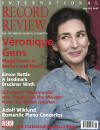Texte paru dans: / Appeared in:
*

International Record Review - (06/2012)
Pour
s'abonner / Subscription information
Mirare
MIR150
3760127221500 (V32)
Consultez toutes les évaluations recensées pour ce cd
~~~~ Reach all the evaluations located for this CD
The first thing to say about this disc is that it has a truly gorgeous sound. The Ricercar Consort has taken a minimalist approach to instrumentation, eschewing any winds other than two Baroque transverse flutes and resisting any temptation to use a bowed string instrument at 8 or 16 foot pitch to reinforce the continuo team of viola da gamba, theorbo ( or occasionally Baroque guitar) and harpsichord. The upper instruments are thus limited to two violins played by the veteran François Fernandez and Australian Sophie Gent and two flutes played by Marc Hantaï and Georges Barthel, while Philippe Pierlot directs the whole ensemble from his basse de viole. The recording was made in one of the Ricercar Consort’s regular venues, the Church of St John the Evangelist at Beaufays in Belgium, whose warmly resonant acoustic, though perhaps verging on too ‘churchy’ for chamber music, is especially flattering to Baroque violins and traversos and bass viols.
The superior sound quality would be for nought without good performances, of course. The Consort plays these serious but entertaining works with considerable charm and superlative technique, sounding at once magisterial and spontaneous. The former quality is in sharp contrast with the majority of other recordings of any of the works, which are usually leaner textured and (generally in a good sense) nervier. François Guerrier’s unfailingly inventive harpsichord accompaniment and Eduardo Egüez’s refined realizations on theorbo (and occasionally a less apposite Baroque guitar) contribute substantially to the ensemble’s arresting account of these fairly familiar works.
The Consort has separated Couperin’s two lengthy and incident-filled Apothéoses, obsessed as they are with reconciling the very different Italian and French styles, with the often recorded Tombeau de Monsieur de Lully by its subject’s pupil, Jean-Féry Rebel, which is also in a kind of goûts réunis style. It combines a Corellian trio sonata texture with a French basse de viole and also mingles the French lutenists ‘and harpsichordists’ tombeau form, touches of French opera (such as the sommeil-like sombre first movement) and idiomatic Italianate writing for the violins . The third suite en trio of Couperin’s 1724 collection containing the two Apothéoses, entitled La Paix du Parnasse, completes the programme; but before we reach it we encounter one of the most singular parts of the recital, the last four movements of the Apothéose composé à la mémoire immortelle de 1’incomparable Monsieur de Lully. This passage is extraordinary for Couperin’s supremely skilful writing for two unaccompanied violins, representing Corelli and Lully, which alternate as principal and accompanying instrument, each simultaneously playing in its own national style. It is all the more outstanding for the way Fernandez and Gent maintain with exemplary clarity the stylistic differentiation between the two parts.
As is common in recorded performances, the lengthy descriptive titles of the movements of the two Apothéoses are recited by François Morel, an actor. Although he has an attractive light voice and avoids the over-ripe declamation too frequently encountered on discs of these works, it would have been nice if he had been allocated separate tracks so as to allow the listener the option of sometimes programming him out of the recital.
There is little otherwise to fault this
production, which includes attractive Mirare packaging, full track details
and an informative essay by the Couperin authority Philippe Beaussant —
except that, as with all Mirare discs, the booklet is glued inside the
trifold digipak, making it less comfortable than it should be to read and
ensuring increased wear on both the booklet and the fragile cardboard
packaging.
Fermer la fenêtre/Close window
Cliquez l'un ou l'autre
bouton pour découvrir bien d'autres critiques de CD
Click either button for many other reviews


